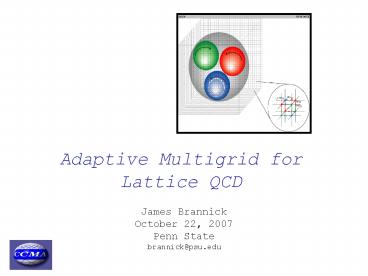Adaptive Multigrid for Lattice QCD - PowerPoint PPT Presentation
1 / 22
Title:
Adaptive Multigrid for Lattice QCD
Description:
Participants in the MG-QCD project. A. Bessen (Columbia University) ... Generalized Curl (Maxwell) The Dirac PDE (for Quarks) x = (x1 ,x2 ,x3 ,x4 ) (space,time) ... – PowerPoint PPT presentation
Number of Views:41
Avg rating:3.0/5.0
Title: Adaptive Multigrid for Lattice QCD
1
Adaptive Multigrid for Lattice QCD
- James Brannick
- October 22, 2007
- Penn State
- brannick_at_psu.edu
2
Presentation plan
- Intro to Lattice Quantum Chromodynamics
- Review of Multigrid Basics
- (Adaptive) MG for QCD
- Numerical Experiments
3
Participants in the MG-QCD project
- D. Keyes (Columbia University)
- O. Livne (Univ. of Utah)
- I. Livshits (Ball State)
- S. MacLachlan (TU Delft)
- T. Manteuffel (CU Boulder)
- S. McCormick (CU Boulder)
- V. Nistor (PSU)
- K. Osterlee (TU Delft)
- J. Osborne (ANL)
- C. Rebbi (BU)
- J. Ruge (CU Boulder)
- P. Varanas (LLNL)
- A. Bessen (Columbia University)
- A. Brandt (UCLA, WIS)
- J. Brannick (PSU)
- M. Brezina (CU Boulder)
- R. Brower (BU)
- M. Clark (BU)
- R. Falgout (CASC-LLNL)
- A. Frommer (Wuppertal)
- K. Kahl (Wuppertal)
- C. Ketelson (CU Boulder)
4
Forces in Standard Model SU(N)
Nuclei Weak N2 (isospin)
Atoms Maxwell N1(charge)
Sub nuclear Strong N3 (color)
Standard Model U(1) SU(2) SU(3)
5
(No Transcript)
6
QCD path integral
quark
Anti-quark
Gauge
Dirac Operator
Generalized Curl (Maxwell)
7
The Dirac PDE (for Quarks)
3x3 color gauge matrices
x (x1 ,x2 ,x3 ,x4 ) (space,time)
4 x 4 sparse spin matrices 4 non-zero entries
1,-1, i, -i
Wilson (1974) discretization on a hypercubic
lattice
U(x,x?) expi hg A?(x)
8
Discrete Dirac operator on hypercubic lattice
Spin projection Operator
Color a,b 1,2,3
Dimension ?1,2,,d
x
x?
Spin i,j 1,2,3,4
x2 axis ?
x1 axis ?
9
Wilson fermion matrix M
/
10
2-d toy problem Schwinger Model
- Space time is 2-d
- Gauge links U(x,x?) expi e A?(x), U(1)
theory - Dirac fields have 2 spins (not 4)
- Operator is quaternionic (Pauli) matrix
involving??1, ?2
11
Spectrum of Schwinger matrix critical slowing
down
mass gap .1
mass gap .01
mass gap .001
12
Stationary Linear Iterations
- Consider solving the linear system
using a SLI - Let eku - uk be the error, and note that
rkAek. The error - propagation operator is then
, with rkf - Auk
13
Multigrid V-cycle
Multigrid solvers are optimal (O(N)
operations), and hence have good scaling potential
prolongation (interpolation)
MG uses a sequence of coarse-grid problems to
accelerate the solution of the original problem
restriction
14
Why does standard MG work?
- Low mode is constant -- key to MG success is
smooth error, e.g., Laplacian - Constant exactly preserved on coarse level
- All near zero modes also preserved!
15
Lattice QCD MG
- Gauge field and hence low modes not geometrically
smooth (locally oscillatory)
Lowest mode of M, 6
Geometric MG completely fails, preserving low
modes for gauge fields requires adaptivity
16
Lattice QCD (A)MG
- Lattice QCD and MG have a long and painful
history (15 yrs.)
PTMG (Lauwers et al, 93) Renormilazation MG
(de Forcrand et al, 91) Projective MG (Brower
et al, 91) Many others ..
All failed for non-smooth fields in the m ! mcr
limit, failed because did not consider why MG
works in first place!
Diamond Jacobi Circle CG Square V-cycle Star
W-cycle
17
Adaptive Smooth Aggregation AMG
Adaptively use (s)low modes to define the
evolving V-cycle
Initial Algorithm Setup 1. Relax on Ax 0,
with random initial guess (resulting
error is repesentative of (s)low modes). 2.
Cut vector into pieces over aggregates (blocks).
3. Define the prolongator so that x Px .
4. Smooth the vector using simple Richardson
iteration P (I - A)P, choosen to
minimize condition number of coarse scale
operator A ((I- A)P)A(I- A)P.
c
c
General setup adaptive process
repeated with current solver to
find additional vectors as needed
18
Adaptive Smooth Aggregation MG
- Adaptive SA designed for problem without
underlying geometry - Uses algebraic defintion of strength of
connection to define aggregates - QCD defined on regular lattice with unitary
connections and so use regular geometric blocking
strategy - (i.e., 4 x n x n )
- Maintains simple regular geometry on coarse
scales, allowing for perfect - load balancing and minimal comm.
- Original algorithm requires HPD operator and thus
we solve M M
19
Results for M M
- Schwinger model, 2-d with U(1) background on128 x
128 lattice with 6,10, Q 0,4, - mass gap 0.001 - 0.5
- Use 4 x 4 ( x 2 ) blocking and 3 levels with 8
vectors - Under-relaxed MinRes smoother (Bank and Douglas)
- Compare MG-PCG with CG
20
Results
6
10
- Critical slowing down eliminated!
- No dependence on
- Dramatic improvement over CG
Adaptive Multigrid for QCD, Brannick, Brower,
Clark, Osborne, and Rebbi, Phys. Rev.
Letters, sub. 2007. Adaptive Multigrid for
Wilson Fermions, Brannick, Brower, Clark,
Osborne, and Rebbi, Proc. of Science
Lattice 07, sub. 2007.
21
Results MG for M
6, N 128
- Huge reduction of flops
- Fewer vectors needed
- Develop. of code for full 4-d QCD underway
Adaptive Multigrid for the non-hermitian Wilson
operator, Brannick, Brower, Clark,
Osborne, and Rebbi, in preparation.
22
Possible future collaborations
- Current projects (with J. Xu L. Zikatanov)
- Radiation transport
- Electromagnetics
- Oil resevoir simulations
- Fuel cell dynamics
- Stochastic matrices
- Lattice field theories































